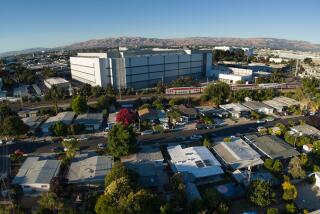SDG&E; Sells Its Geothermal Leaseholds
- Share via
SAN DIEGO — San Diego Gas & Electric last week sold its Imperial Valley geothermal leaseholds to Los Angeles-based Magma Power in a deal that, depending on how productive the geothermal fields prove to be, could reach $30 million.
“The (ceiling) payment is $30 million, and I expect we’ll see it,” said Jim Nugent, supervisor of fuel contracts for SDG&E.; “We’ll recover more than we put into (purchasing) leaseholds . . . (and) as those payments come in, they’ll reduce future electric rates.”
“We’ve more than bailed out the ratepayers for what they spent to acquire the leaseholds” during the 1970s, said James D. Shepard, a spokesman for Magma Power, the Los Angeles geothermal power company that acquired the leaseholds, near Niland in the Imperial Valley.
According to the terms of last week’s sale, Los Angeles-based Magma paid $3 million to New Albion Resources Co., the SDG&E; subsidiary that owned the leaseholds. Magma will pay an additional $1 million for each future plant that it builds, and pay royalties based on the productivity of the geothermal fields during coming years.
Magma, which operates a geothermal plant at Niland that generates 34 megawatts of electricity for sale to Southern California Edison, plans to build at least three other geothermal plants nearby that would supply electricity to Edison.
The leasehold sale does not mean that SDG&E; has lost faith in the geothermal technology that pumps superheated steam or “brine” from below the earth’s surface to turn above-ground generators that produce electricity. SDG&E; anticipates that geothermal will generate 11% of its electric power needs in 1990.
SDG&E; sold the leaseholds to Magma because state regulators--who encouraged utilities to acquire energy leaseholds during a 1970s energy crunch--have reversed field and forced SDG&E; and Edison to rid themselves of leaseholds.
SDG&E; has been operating a $188.5-million demonstration geothermal plant at Heber in the Imperial Valley since June, 1985. The utility expects that the Heber plant will prove the “binary” technology that uses lower-temperature brines found at Heber instead of the superheated steam and brines that power most other geothermal plants.
The plant transfers heat from the brines to the so-called “binary” system that turns turbines, generating 22.5 megawatts of electricity. Pumping those brines eats up about 13 megawatts, and just over 9 megawatts are fed into SDG&E;’s electric transmission system.
A second set of wells being drilled could boost the plant’s capacity to 70 megawatts, of which about 23 megawatts would be fed into SDG&E;’s transmission lines.
Heber’s ability to compete with lower-cost power sources will be determined in part by how much electricity is needed to pump the brine from underground reservoirs.
Although the plant was dogged by equipment failures during its first six months of operation, it has been on line since then for 93% of time. The plant, which was shut down in June for repairs, will go back on line next week, according to Tiffany Nelson, a senior engineer at the Heber plant.
The Heber plant, which draws more than 50% of its funding from the federal government and several utility partners, will operate as a demonstration plant through mid-1988. At that time, SDG&E; must determine if Heber can compete with existing electric generating plants that burn lower-cost gas and oil.
Technically, “things are looking real good,” Nelson said.
However, the plant’s future “depends on the economics” in 1988, according to Nugent.
More to Read
Inside the business of entertainment
The Wide Shot brings you news, analysis and insights on everything from streaming wars to production — and what it all means for the future.
You may occasionally receive promotional content from the Los Angeles Times.










